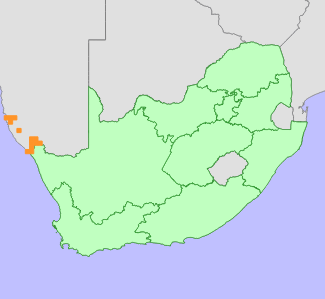|
Scientific Name | Osteospermum polycephalum (DC.) Norl. |
Higher Classification | Dicotyledons |
Family | ASTERACEAE |
Synonyms | Tripteris limonifolia DC., Tripteris polycephala DC. |
National Status |
Status and Criteria | Least Concern |
Assessment Date | 2015/05/21 |
Assessor(s) | L. von Staden |
Justification | This species has a limited distribution range in South Africa, but is widespread across southern Namibia. In spite of population decline in places due to habitat loss and degradation, it is still common and not yet in danger of extinction. |
Distribution |
Endemism | Not endemic to South Africa |
Provincial distribution | Northern Cape |
Range | Coastal plains of southern Namibia and South Africa between Lüderitz and Port Nolloth, and inland along the lower Gariep Valley. |
Habitat and Ecology |
Major system | Terrestrial |
Major habitats | Desert, Succulent Karoo |
Description | Deep sandy soils on plains and dry riverbeds. |
Threats |
| On the Namibian and South African coast, as well as at places along the lower Gariep Valley, this species is threatened by ongoing habitat loss and degradation due to mining. It is also threatened across its range in South Africa by severe overgrazing. |
Population |
This species is still fairly common in the Richtersveld, including the coastal flats around Alexander Bay. It is widespread and common in Namibia, but also declining in places due to habitat loss.
|
Population trend | Decreasing |
Assessment History |
Taxon assessed |
Status and Criteria |
Citation/Red List version | | Osteospermum polycephalum (DC.) Norl. | Least Concern | 2014.1 | | Tripteris polycephala DC. | Least Concern | Raimondo et al. (2009) | |
Bibliography |
Manning, J.C. and Goldblatt, P. 2012. Plants of the Greater Cape Floristic Region 1: The Core Cape Flora. Strelitzia 29. South African National Biodiversity Institute, Pretoria.
Norlindh, T. 1943. Studies in the Calenduleae. 1: Monograph of the genera Dimorphotheca, Castalis, Osteospermum, Gibbaria and Chrysanthemoides. Gleerup, Lund.
Raimondo, D., von Staden, L., Foden, W., Victor, J.E., Helme, N.A., Turner, R.C., Kamundi, D.A. and Manyama, P.A. 2009. Red List of South African Plants. Strelitzia 25. South African National Biodiversity Institute, Pretoria.
Snijman, D.A. 2013. Plants of the Greater Cape Floristic Region 2: The extra Cape flora. Strelitzia 30. South African National Biodiversity Institute, Pretoria.
|
Citation |
| von Staden, L. 2015. Osteospermum polycephalum (DC.) Norl. National Assessment: Red List of South African Plants version 2024.1. Accessed on 2025/11/18 |
 Comment on this assessment
Comment on this assessment


